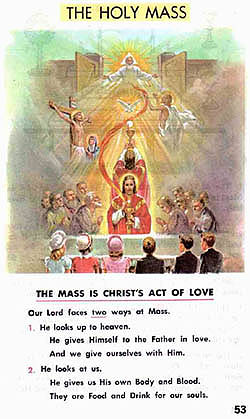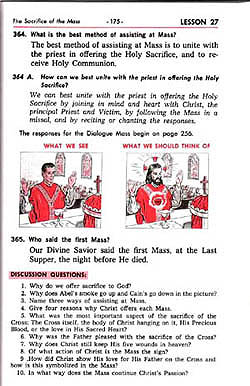 |
What People Are Commenting
Hybrid Mass, Good Customs & Phenomenology
Hybrid Mass and Hegelianism

|
Dear Mr. Guimarães,
In your article, "Heading to a Hybrid Mass," you stated:
"There is nothing new in this ruse. After the excesses of Arianism, the Church had to face the much more attractive Semi-Arianism. It is usually said that almost the whole Hierarchy apostatized under Arianism. This is not accurate. It happened under Semi-Arianism. It was against this second stage of the heresy that only St. Athanasius and St. Hillary of Poitiers stood heroically. Pope Liberius signed the Semi-Arian formula, not the one before it, already condemned in Niceae. So, the almost complete capitulation took place under a 'more moderate' and 'more conservative' version of Arianism.
This process of stepping back in appearances to save heretical conquests has been repeated time and time again: after Pelagianism came Semi-Pelagianism; after Protestantism came Jansenism; after Modernism, a moderate neo-Modernism called Progressivism began to surface in the 1930s. It only became a bold public movement after Vatican II."
So then we have with Arianism historically, not a Hegelian dialectic, of thesis followed by anti-thesis followed by synthesis. But, thesis (Catholic orthodoxy) followed by anti-thesis (Arianism), followed by synthesis (Semi-Arianism), followed by the triumph of thesis (Catholic orthodoxy)? Would you agree with that statement? If so, would you say Pelagianism follows the same pattern?
Thank you,
M.M.K.

The Editor responds:
Dear Mr. M.M.K.,
Hegelianism, like many pagan theories that try to explain the Philosophy of History, is determinist. That is, it supposes a blind fate, which is accomplished throughout a cycle of phases that has to happen inexorably. This supposed inevitable process excludes the role of the human will.
The Catholic Philosophy of History is different. It studies the natural laws that influence human psychology and sociology, of course, but it also considers the Theology of History. The latter is the study of the plans of God for mankind, the action of the good Angels in helping these plans be achieved, the action of the Devil and his cohorts in trying to prevent them, and, finally, the action of men in collaborating with God or the Devil following their own free will.
Neither the natural laws of psychology and sociology, nor the supernatural or preternatural actions are decisive in themselves to direct History along this or that path. They invite and influence man to go in this or that direction. The final decision, however, is human. In it each one of us has a proportional role to play.
In my opinion, the fundamental refutation of Hegelianism consists in showing that it is a blind and self-determined process at variance with reality. As a matter of fact, historical reality relies on the free will of men.
Applying this to the case of the first heresies, certainly they employed the tactic of presenting their errors in a diluted form after an initial condemnation. However, this tactic should be considered as a moral ruse used by heretics, rather than a law of Philosophy or the Theology of History.
I hope this may help you to refute Hegelianism more efficiently.
Cordially,
A.S. Guimarães

Hybrid Mass even in Traditional Catechisms

|
Dear TIA,
I offer the following as a warning to Traditional Catholics who may feel too safe in their chosen traditional Catholic parish, and do not believe that Progressivism could gain a foothold in their life. I am referring here to the hybridizing of a Mass with the Novus Ordo as explained by Mr. Guimarães.
Picture 1

Picture 2

|
One picture of this kind of hybrid is available in the children's New Saint Joseph First Communion Catechism (Picture 1), whose text claimed to be "Prepared from the Official Revised Edition of the Baltimore Catechism" (no.2). This text and the page reproduced from it here was provided for the instruction of youth by a Traditional Priest in a Traditional Parish run by a large Traditional organization. In addition, the booklet can be found as part of the curriculum in at least one traditional home school bookstore.
Despite the claim, the page in question cannot be found in the Baltimore Catechism, neither the hybridized picture nor the poorly attempted justification beneath the picture. I have included corresponding pictures from the revised Baltimore Catechism for comparison. These pictures essentially speak for themselves, but please note the following blatant aberration:
In the picture in the Baltimore Catechism (Picture 2), the position of the priest [facing God] clearly shows the Mass as being said before the altar of Our Lord's sacrifice, with the priest turning to face the people to give Communion, as is done in the Mass. In the hybrid picture (Picture 1), Our Lord is clearly depicted saying Mass behind the altar [facing the people] as one would see at a Novus Ordo service. In addition, we are told that "Our Lord faces two ways at Mass." Well then, why wouldn't a child so instructed naturally assume that if Our Lord can face two ways, why not his Priest?
Looking at these pictures, one can understandably ask why such a modern lesson would be given to Catholic children. Looking at the 1963 copyright, one could reasonably suspect that a hybrid service had been planned for quite some time. Looking at reality, not at what we imagine, one might reasonably ask why this has made its way into certain Traditional Catechetics. Could it be, perhaps, that the progressivists have comfortably found their way in?
Tolle Causam!
Dr. Pamela Dettman

Pinay's Plot against the Church

|
Dear Marian Horvat,
I enjoy studying your articles on all topics and feel you and Guimarães do a good job. I have been studying The Plot Against The Church by Maurice Pinay [a pseudonym], a pre-Vatican II book, which I have got to believe that you and Guimarães have read or are likely familiar with.
This book was prepared for the express purpose of warning and informing all the attendees of the Council about the real purpose of the Council.
In the "Introduction" to the Italian Edition, it is clearly pointed that there was a master plan and what it was, namely to get the Church in a position to contradict itself and all previous teachings. This would then demonstrate to the world that the Church could not be of Divine origin, since God cannot contradict Himself. That, of course, would pull the rug out from under Jesus' claim to be God. And guess who fosters that idea and who he has working for him?
This is a very clever plan and seems, ever since the Council, to be working just as slick as can be. We have seen Paul VI mess up the Mass, JP II kiss the Koran, seen him and Ben XVI attend synagogue services, pray with pagans [in violation of the 1st Commandment it would seem], apologize for the actions of numerous events in Church History, introduce a completely new "mass", and redefine who is the Church of Jesus, and on and on.
I still believe the Novus Ordo is valid, depending on the priest, just because we still see Eucharistic Miracles happen, and in this case I think of Naju Korea in spite of recent events.
I'm a 79-year-old cradle Catholic who grew up with and in the Catholic Church when it truly was Jesus' Church, and priests, nuns, and Bishops acted and looked the part too.
Thanks for the chance to comment on a few things.
J.F.

Articles on History and Good Manners

|
Dear TIA,
Love, love all your articles on Catholic history and the ones relating to the first to come to America were not the English.
You have one I am presently reading on El Paso and the First American Thanksgiving.
Recently I read a book called A Cross in the Sand by a professor from University of Florida (forgotten his name for the moment) and he tells about the Spanish entering Florida. As we know St. Augustine was named by them and one of the earliest settlements. I have also heard before that Jamestown was not the first settlement in America.
The Spanish were in Florida much earlier and in A Cross in the Sand the author explains they had the first American Thanksgiving with the native Indians in that State. He also relates how the English kept moving down from the north, and how Spain lost many of its settlements. If you read this book, would you please write an article for your Tradition in Action?
Thank you very much, Marian, for all you write. Also enjoy your columns in the Catholic Family News on Good Manners. How can we be a civilized nation without God, and then good manners follow. The Faithful then learn to live good sacramental lives and pass it on to their children.
Viva Christo Rey!
S.F.

Phenomenology and Progressivism

|
Dear Sir,
How right you are - this is the era of Phenomenology in the neo-modernist drive for the "razing of bastions" in the Catholic Church. As Professor Amerio rightly stated, anything can be said about anything in the Post-Conciliar Church, even totally absurd contradictions. They pass by the unwitting, dull-minded, modern materialist "catholic" as some type of magisterial dogmatic formulae.
As John Paul II (RIP) was one of the main instigators in the Church of this secular post-modernist philosophy which relativizes anything and everything into a subjectivized confusion of a presupposed subconscious reality, then one can immediately comprehend how sanctity on Earth has become a personalized instrument of validating personal modernist papal perspectives on the faith: religious indifferentism & alleged illusory "miracles" can be recognized by rushed beatifications and canonizations. One can comprehend how a Pope can say in the same breath that two totally opposite and incompatible rites of liturgy are the same rite but two forms, and how devious terminology with elasticity of signification can be manipulated to appear orthodox from one angle but entirely liberal from another.
Indeed, Husserl has had an immense and unmerited influence on the post-conciliar ecclesiastical establishment and has inaugurated the era of itching ears and false prophets about which St. Paul admonished the Church almost 2000 years ago. It cannot be left unnoticed that the Church is evidently being prepared for divine judgment.
In Christo Domino et Maria,
H.M., Social Science lecturer

Posted March 4, 2008

The opinions expressed in this section - What People Are Commenting -
do not necessarily express those of TIA

Related Topics of Interest
 The Motu Proprio, after the Emotions The Motu Proprio, after the Emotions
 Heading to a Hybrid Mass Heading to a Hybrid Mass
 The First Thanksgiving Were Catholic The First Thanksgiving Were Catholic
 Benedict XVI Inside the Synagogue of Cologne Benedict XVI Inside the Synagogue of Cologne
 JPII at the Synagogue in Rome JPII at the Synagogue in Rome
 The Pope at the Mosque - A Scandal The Pope at the Mosque - A Scandal


|
Comments | Questions | Objections | Home | Books | CDs | Search | Contact Us | Donate

© 2002-
Tradition in Action, Inc. All Rights Reserved
|
 |
|